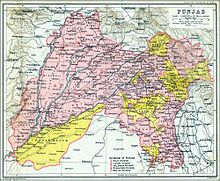Agency of British India
The Punjab States Agency was an agency of the British Raj . The agency was created in 1921, on the model of the Central India Agency and Rajputana Agency , and dealt with forty princely states in northwest India formerly dealt with by the Province of Punjab .[1] [2] [3]
After 1947, all of the states chose to accede to the Dominion of India , except Bahawalpur , which acceded to the Dominion of Pakistan .
History
The princely states had come under the suzerainty of the British crown after the Anglo-Nepalese War of 1814–16 and went on to be known as the Punjab Native States and the Simla Hill States. They later came into direct diplomatic relations with the British province of Punjab , with the exception of Tehri Garhwal State , which had a connection instead with the United Provinces .[4]
The Punjab States Agency was established in 1921 out of the previous Punjab Native States, which had received advice from the Lieutenant Governor of Punjab Province , and the Simla Hill States , advised by the Deputy Commissioner of Simla district .[5] Shimla .[6]
After Indian Independence in 1947, the states all acceded to the new Dominion of India , most of them later becoming part of the new state of Himachal Pradesh , with Tehri Garhwal State becoming part of Uttar Pradesh . In 2000, the northern portion of Uttar Pradesh, including the former state of Tehri-Garhwal , became the new state of Uttarakhand .
Princely states
Punjab States Agency
Salute states , by precedence :
Patiala , title Maharaja, Hereditary salute of 17-guns (19-guns local)Bahawalpur (now in Pakistan), title Nawab, Hereditary salute of 17-guns (later promoted to 21 guns by the Pakistani president)Jind , title Maharaja, Hereditary salute of 13-guns (15-guns personal and local)Kapurthala , title Maharaja, Hereditary salute of 13-guns (15-guns personal and local)Nabha , title Maharaja, Hereditary salute of 13-guns (15-guns local)Kaithal, title Bhai ( Maharaja) Hereditary salute 13-guns (15-guns local)
Bilaspur (Kahlur) , title Raja, Hereditary salute of 11-gunsChamba , title Raja, Hereditary salute of 11-gunsFaridkot , title Raja, Hereditary salute of 11-gunsMaler Kotla (Malerkotla) , title Nawab, Hereditary salute of 11-gunsMandi , title Raja, Hereditary salute of 11-gunsSirmur (Nahan) , title Maharaja, Hereditary salute of 11-gunsSuket (Sundarnagar), title Raja, Hereditary salute of 11-gunsLoharu , title Nawab, Hereditary salute of 9-gunsNon-salute states, alphabetically :
Annexed States:[8]
Bahadurgarh, title Nawab, annexed 1857[7]
Ballabgarh, title Raja, annexed 1857
Farrukhnagar, title Nawab, annexed 1857[9] [10]
Jhajjar, title Nawab, annexed 1857[7]
Jagirs
Kunjpura, title Nawab[10]
Arnauli, title Bhai[10]
Karnal, title Nawab[10]
Shantiabad, title Sardar[10]
Dhanaura, title Sardar[10]
Tangaur, title Sardar[10]
Jharauli, title Sardar[10]
Shamgarh, title Sardar[10]
Panipat, title Nawab[10]
Shahzadapur, title Sardar[10]
Mustafabad, title Sardar[10]
Gogripur, title Chaudhary[10]
Simla Hill States Superintendency of the Punjab States Agency
Salute states :
Sirmur , title Maharaja, 11 Gun saluteBashahr , title Raja, Personal 9 guns-saluteNon-salute states, alphabetically:
Dynasties by State
The following are the dynasties of respective states of the Punjab Agency:
Salute states , by precedence:
Non-salute states, alphabetically :
Annexed States:
^ David P. Henige (2004). Princely states of India: a guide to chronology and rulers . Orchid Press. ISBN 978-974-524-049-0 ^ Princely States of India ^ Chisholm, Hugh , ed. (1911). "Punjab" Encyclopædia Britannica ^ V. Verma, The Emergence of Himachal Pradesh: A Survey of Constitutional Developments , pp. 41-42
^ John Hutchison and JP Vogel, History of Punjab Hill states ; Lahore 1933
^ Ramesh Chandra Bisht, International Encyclopaedia Of Himalayas , Vol. 3, p. 104
^ a b c d e f Gazetteer of the Rohtak District . 1883–1884. p. 22.^ experts, Arihant (2018). Know your state Haryana . Arihant Publication India Limited. ISBN 978-9350947890 ^ Sharma, Suresh. Haryana: Past and Present . p. 110. ^ a b c d e f g h i j k l m n "Revolt of 1857 and muslims in Haryana" (PDF) . Shodhganga : 114.^ a b c d e f g h i j k l m n o Lethbridge, Sir Roper (1893). The Golden Handbook of India . p. 412. ^ Griffin, Sir Lepel H (1865). The Punjab Chiefs . p. 56. ^ "Raja Nahar Singh Palace" . HaryanaTourism . Archived from the original on 28 June 2015. Retrieved 4 July 2015 .
Punjab States Agency Historical Punjab Hill States Simla Hill States Superintendency
30°6′N 77°10′E / 30.100°N 77.167°E / 30.100; 77.167

